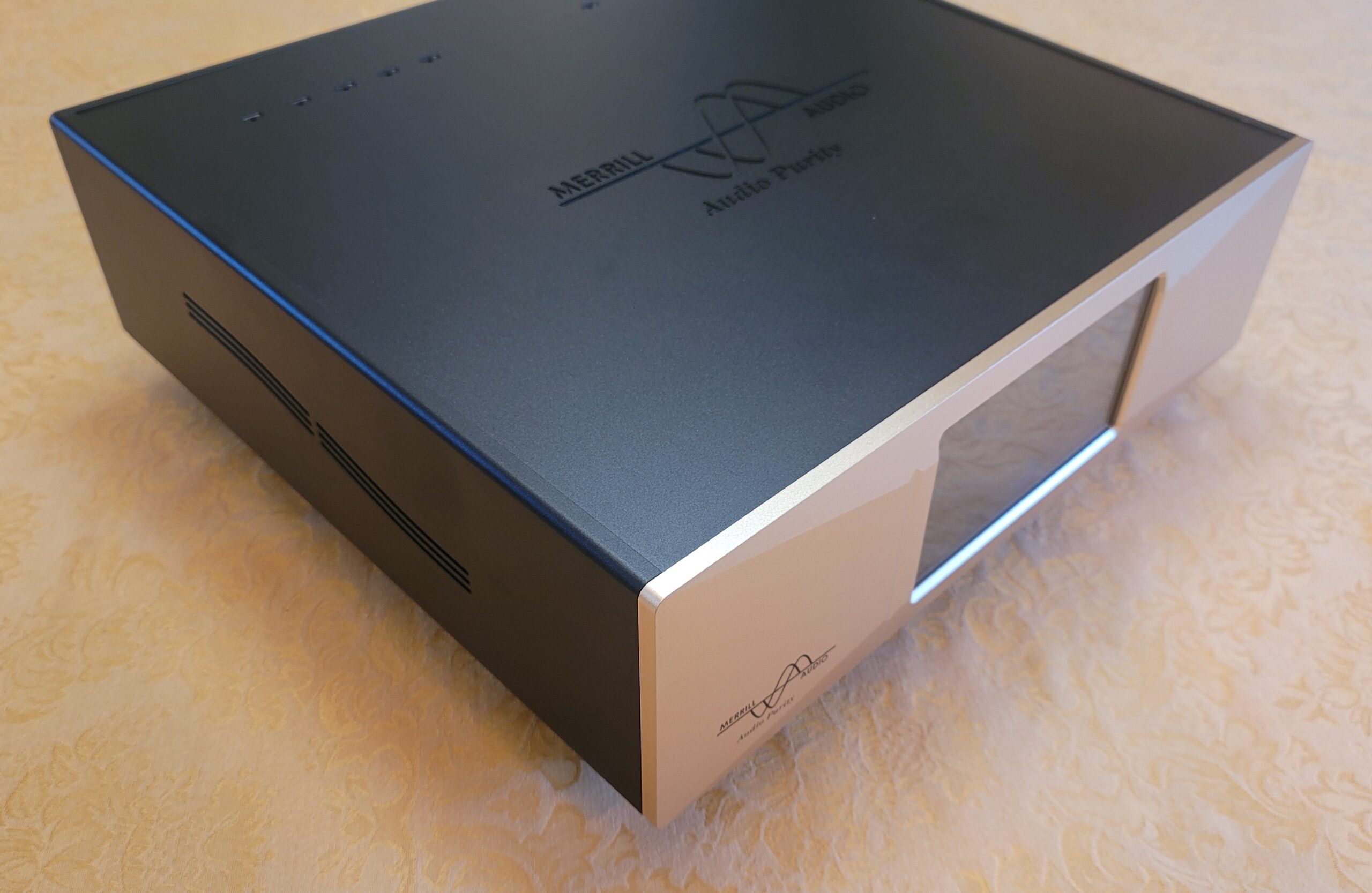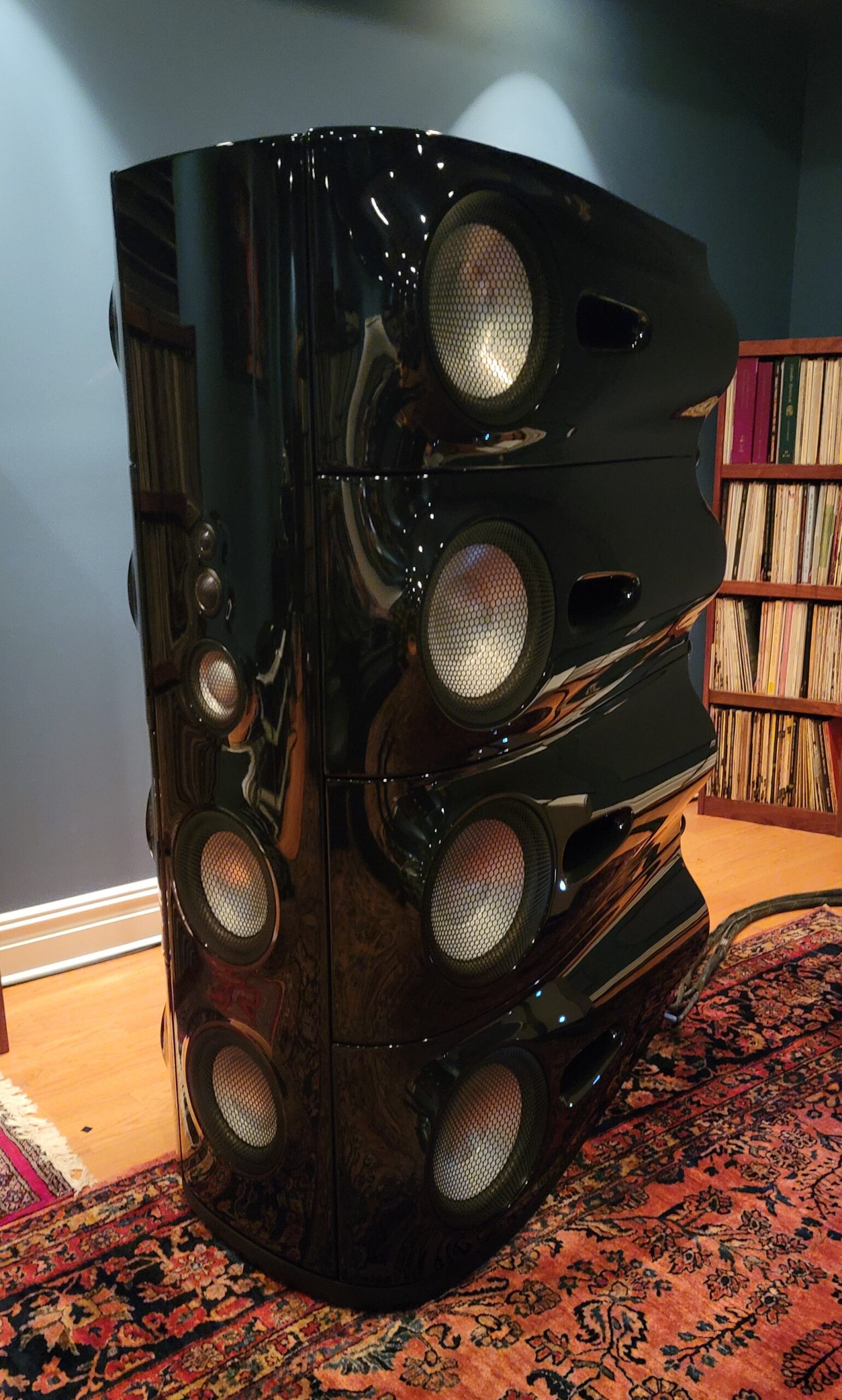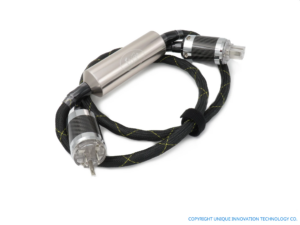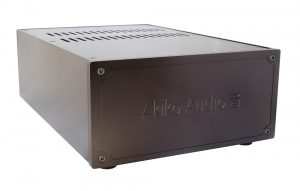Dean Waters at the Pacific Audio Fest 2023 (photograph and image processing by David W. Robinson)
If you wanted to set out to build the most perfect power source solution for your system, you'd be hard pressed to do better than Paul & Scott McGowan and their team at PS Audio. They have created a series of power stations called the DirectStream PowerPlant regeneration units. These rather hefty devices take wall-current coming from the power company and use that power to create a near-perfect sine wave of power to be delivered to your components. This is done by first converting the AC wall-current to a DC current, and then using that DC current to generate a new sine wave of power.
PS Audio product images courtesy of PS Audio
One of the problems we have with typical power filters and other "conditioning" equipment is that they are limited in what they can do based, on the quality of the power that's being fed into them. For instance, let's say that the input AC current isn't exactly 50Hz or 60Hz. A filter cannot correct for this. Also, voltage dips at the source will flow through a typical power filter to the filter's output. The filters can help prevent dangerous spikes and UPS's can compensate for voltage drops to an extent. But if you really want to have great power, the first thing you need to do is throw away the power coming to you from your utility company.
Ok, so that's an over-simplification of course.
Rather, it is better to use the incoming power to make a brand-new source of power. The advantages are numerous and significant. For starters, you can precisely manage the output voltage. If you want exactly 120volts, you can have it. If you want a few volts higher or lower, you can have that. Here in the US, we see that our equipment is designed for a range of voltages from around 110v to around 125v. That's a pretty big swing of voltages, with a sweet spot located in there somewhere. Part of the reason is that voltage from the power company is constantly changing, and fluctuates inversely with current draw. What happens when you turn on a hair dryer, portable heater, or the home air-conditioner kicks on? The lights flicker. What you're seeing is a voltage drop due to the inrush current demands of whatever high-draw device just kicked on.
Let's discuss for a moment the difference between regulated vs. un-regulated power and why it matters. Power (Watts) equals Volts times Amps (current). The current draw of our equipment will fluctuate continuously as we use it. The draw from power amps goes up and down constantly as the music gets louder and softer, for example. When the current demand changes ('draw'), the voltage must also change, in order to keep the same amount of power (Watts). This is an example of what unregulated power looks like.
This is what causes the lights to dim when you turn on the air-conditioner. Power delivered to you by your utility company is unregulated. So as your amplifiers draw more power, everything will experience a voltage drop. The sine wave being supplied gets smaller (measured peak-to-peak). This isn't what we want for our equipment or our ears. Regulated power, however, has additional circuitry that will keep the voltage steady regardless of the current draw demands. This is what PS Audio's PowerPlants provide. If you measure the sine wave coming out of the PowerPlant, it will not change even as the connected components continually vary their current draw. Since the PowerPlant changes input power from AC to DC and then creates a new AC sine wave, it can instantly vary the amount of inbound AC current needed to keep the output voltage steady. Regardless of the demands of individual components, all connected equipment will still receive the exact voltage that you've set.
MultiWave
One of the more advanced features of the PowerPlant which you may find useful is the MultiWave feature. In a nutshell, MultiWave allows a second, higher frequency sine wave to be introduced along with the base frequency (50Hz/60Hz) on the outputs of the PowerPlant. Specifically, a 180Hz wave is introduced on top of the (US) 60Hz signal being generated. If you're not in the US, then the PowerPlant will generate a 150Hz signal on top of the standard 50Hz signal. This signal is the 3rd harmonic of the primary signal. Harmonics are whole-number multiples of a frequency of a signal. The 1st harmonic, also called the fundamental, is the base frequency (50Hz/60Hz). Thus the 2nd harmonic would be exactly double the fundamental. In musical terms, this would produce a sound exactly one octave higher than then fundamental. The PowerPlant multi-wave generates a 3rd harmonic (sometimes referred to as "3rd order" harmonic), which is—you guessed it—exactly three times fundamental. If there were a sound wave, this harmonic would sound an octave-and-a-fifth higher than the fundamental frequency.
So what's the purpose? When Paul and his team at PS Audio were developing power regenerators, they were able to play with the frequency of the power being generated. It all started with the question "What makes 60Hz sacred in the first place?" As the base frequency of the power was increased initially from 60Hz to 90Hz a significant change was noticed in the sound being created by the attached equipment. As Paul describes it, the top end "opened up as if one had removed a blanket from the sound." As the frequency was increased further, next to 120Hz and then all the way up to 400Hz, the midrange also opened up and the sonic depth increased.
However, nothing is free and as the frequency was increased, the low end began to get tight and anemic. After much work and consultation with a friend of Paul's who happened to be both an audiophile and a scientist at Northrup Grumman, the answer discovered was to introduce a higher frequency on top of the standard (US) 60Hz signal being generated. The amount of this 180Hz frequency can be varied by the user in several discrete steps. It can also be switched off entirely. And it can be done so from the handy remote control that ships with the PowerPlant. So without leaving the listening position, you can modify the power shape and hear the results, and then dial in exactly how much of this 3rd order harmonic (if any) you want to add to your system.
Included multi-function remote
There is also a second benefit to MultiWave as well. Within the filter circuits of our various power supplies that drive the components of our systems lie capacitors that are used to even and smooth out the current from the rectifier circuits.
Photograph by Dean Waters
These capacitors, like all capacitors, charge when the current is positive and discharge when current is being drawn at a higher rate than what is being supplied to the capacitor. If you consider a basic sine wave, you see that a capacitor receiving the sine wave as a power signal will 'ramp-up' its charging rate as the sine wave increases from 0 degrees of phase up to 90 degrees.
Photograph by Dean Waters
The charging rate then decreases during the 90-to-180 degree of phase. Depending on how well our various component power supplies are designed, you could find yourself in a power deficit (voltage drop) during high-draw demands. This could be during sudden volume spikes in the music which require additional current to power large drivers in speakers. MultiWave addresses this by changing the overall shape of the wave being supplied. When two or more waves of any type and shape are added to a medium (like a cable), the net-result is the summation of the waves. Thus, it would look something like this:
The first line shows a pure 60Hz signal that would be generated by a PowerPlant with MultiWave disabled.
The second line is the MultiWave 3rd harmonic (180Hz) that's being added to the fundamental (60Hz) wave.
The third line is the summation of the first (60Hz) and second (180Hz) frequencies. This is what's being placed on the power cables at the output power outlets on the back of the PowerPlant.
Notice that the ramp-up time at the beginning of each cycle is much faster when you combine both 60Hz and 180Hz. Also, the amount of positive-charge time (the amount of time that the power is above the 0-point line) is also increased. This allows capacitors to more fully charge with each cycle. The net-result is more current available to satisfy transient high-current demands from the music, speakers, and connected amplifiers.
Because the PowerPlant is adding pure sine waves together, unwanted harmonics (distortion) are not introduced. Distortion is created from signals other than pure sine waves. Hence, when you observe 2% THD on the incoming circuit, what you're seeing is distortion from a non-pure sine wave being delivered from the wall. Even with MultiWave enabled, THD is about 0.1% being delivered from the PowerPlant. Distortion, with or without MultiWave, is eliminated.
Photograph by Dean Waters
- ~0.1% output THD being supplied from the PowerPlant with MultiWave enabled.
- ~2% input THD being supplied from the utility company through the wall to the PowerPlant.
Degaussing the CleanWave way
In the olden days of television (think 1950s) when your family bought a TV set, it most likely came in a large floor standing cabinet and had to be professionally installed by a trained TV technician. Hard to fathom now, but that's the way it was.
Part of the installation process involved the technician powering up a very high-frequency power coil and passing it over and around the screen. This was known as degaussing your set. Once this was done, you couldn't move your TV without another visit from the TV repairman with his trusty degauss tool.
Years later, TV manufacturers would incorporate automatic degauss coils in TV's surrounding the CRT, thus negating the need for a TV installer, and allowing TV's to be moved at will. Turn on a CRT TV or computer monitor and you'll hear the distinctive high-pitched 'whine' for a few seconds while the TV powers on. That's the built-in degauss coil at work. High-end CRT computer monitors even had a dedicated degauss button that would provide a degauss cycle without needing to power cycle the monitor. Ah, the good old days.
Ok, what does that have to do with audio? Plenty. Any metal item picks up transient magnetic fields when exposed to other magnetic fields. We've all rubbed a magnet against a paper clip and then used that newly magnetized paper clip to pick up other paper clips. Same thing happens in cables (except for the paper clip part…). The PowerPlant has a feature that is designed to remove transient magnetic fields from connected cables and power supplies via the CleanWave function. It's a simple process that can be activated by a single press of a button on the remote. When activated, the PowerPlant will add a series very high frequencies to the main sine wave and will act as a degauss tool. The process runs for a few seconds and can be extended for longer intervals if desired.
Oscilloscope
It's one thing to read about the features and differences in power quality that the PowerPlant provides. It's another thing to see it first-hand. To do this, you'd need an oscilloscope. Fortunately, the PowerPlant has one built in. The touch-screen display, along with the included remote, can be used to configure the unit and also functions as a power oscilloscope. In addition to the various gauges that indicate THD (in & out), power draw in watts, and power improvement factor (the difference between THD in and THD out). The oscilloscope will show the shape of the (imperfect) sine wave coming into the PowerPlant from the utility company, the shape of the pure sine wave being produced by the PowerPlant, and the difference between the two.
Power in
Power out
Difference
There are three models of PS DirectStream Audio PowerPlant available, depending on your needs. The feature-set is the same across all three models, the primary difference being the amount of power available and the number of power outlets. Outlets are grouped into banks of two outlets per bank. The individual banks can be switched on/off via the touchscreen or network interface.
Press an outlet to switch the bank on or off
System power and outlet groups can be controlled via the web-interface with a click
Sound improvements
All of these features are worthwhile in themselves, but only if they improve the listening experience. Otherwise, what's the point?
Image courtesy of iFi Audio
I've been using a KECES S300+ Class A/AB hybrid amplifier paired with an ifi iDSD Pro Signature DAC. Moving the power source on these components from wall-power over to the PowerPlant made a noteworthy difference. The changes were instantly recognizable.
First off, the noise floor of the amp and DAC were reduced. In my experience, this amp and DAC combination can be quite noisy. It turns out that a significant portion of that noise was caused by the THD present in the wall-power. Once the harmonic distortions in the supplied power were removed thanks to the PowerStation, the amp and DAC performance was noticeably improved. The overall sound stage of the music was also enhanced. For me, soundstaging is all about faithful reproduction of the soft sounds. Specifically, the ambient sounds that are captured as part of the recording process that, too often, get lost when we play the music back. With "dirty" power, the distortion increases, and those softer sounds disappear in the noise floor. The result is that soundstaging suffers. With the noise out of the way, the amp and DAC have an opportunity to open up the sound, especially in the mid-range. The sound becomes less constrained and more open and free.
Mola Mola Kaluga Monoblock Amplifiers (image courtesy of Mola Mola)
The Mola Mola Tambaqui DAC (image courtesy of Mola Mola)
I then tried the same power comparisons with a Mola Mola Kaluga amp and Tambaqui DAC combo. Those two devices are exceptional in their own right. (Reviews in the works.) The amp is an efficient class D and the Tambaqui is as transparent a DAC as I've ever heard, with near-zero noise floor. Since these devices are already efficient and quiet, there wasn't much change in the noise. I did detect one sonic difference, which was a more pure and balanced musical presentation from top-to-bottom of the frequency range of the recordings. I'd opine that the square-wave generator in the amp as well as the low-pass filters are given the opportunity to perform at their absolute best with near-perfect power. I'd also say that the built-in upsampling feature of the DAC is also able to perform better when the internal power supply isn't being fed distorted power from the wall.
The KECES S300+ Stereo Amplifier (image courtesy of KECES)
In both cases, with the KECES/iFi iDSD Pro Signature and the Mola Mola combinations, the overall listening experience with power being provided from the PowerPlant produced results that were more open and free with better soundstaging.
To put it even more succinctly, more musical.
Final thoughts
With the introduction of the PowerPlant regeneration units, PS Audio set out to solve the issue of clean regulated power regardless of the condition of power that is provided by the utility company. The quality of power provided into our environment is something generally beyond our control.
This is no longer a concern thanks to Paul MacGowan and his talented team. In addition, with the addition of MultiWave, there is opportunity for sound improvement over and above what can be offered by clean power alone. It's easy to consider this a "must-have" device for anyone serious about music and having components perform at their peak.
Highly recommended.
DirectStream PowerPlant 15
Retail: $7999 10 outlets, 1200VA Maximum continuous load.
For small to medium-sized systems, PS Audio makes a Stellar PowerPlant 3 that supports 300VA Maximum continuous load, has six outlets, and includes both MultiWave and ClearWave. With this model, the MultiWave feature can be either on or off, whereas on the larger DirectStream PowerPlant models, the amount of MultiWave signal present is adjustable.
Stellar PowerPlant 3
Retail: $2999 300VA
Other models for other "sized" systems are:
DirectStream PowerPlant 12
Retail: $5999 8 outlets, 1000VA Maximum continuous load.
DirectStream PowerPlant 20
Retail: $9,999 16 outlets, 2000VA Maximum continuous load.
PS Audio
https://www.psaudio.com/collections/power-regenerators
All photographs by Dean Waters, unless otherwise indicated.
























































